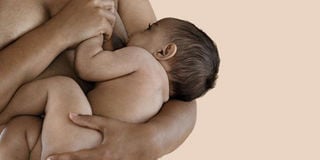More babies infected with HIV, says report

A woman breastfeeds her baby. New HIV infections in children have gone up in the last one year, a new report shows. PHOTO | FILE
What you need to know:
- Report shows that children aged below 14 contributed to 7,978 of new infections in 2017, an increase from 7,105 in 2016.
- The new infections were higher in boys, at 4,044, while girls stood at 3,935.
- An infant is considered HIV-exposed if the mother is HIV-positive.
- Kenya seeks to reduce HIV prevalence in this age group to five per cent of total new infections.
Despite efforts by national and county governments to ensure mothers give birth to HIV-free babies, new infections in children have gone up in the last one year, a new report shows.
The 2018 Kenya Aids Response Progress Report shows that children aged below 14 contributed to 7,978 of new infections in 2017, an increase from 7,105 in 2016.
The new infections were higher in boys, at 4,044, while girls stood at 3,935.
Out of the 52,800 new infections recorded across all ages in 2017, 8,000 were among children between zero and 14 years of age, translating to about 20 new infections per day.
This is despite Kenya adopting the Option B+ programme by Unicef and the joint United Nations Programme on HIV and Aids, where mothers and their newborns receive antiretroviral drugs to keep the baby HIV-negative while still enjoying all the benefits of breast milk.
BREASTFEEDING
An infant is considered HIV-exposed if the mother is HIV-positive. It can get the virus during pregnancy, at birth or while breastfeeding.
However, efforts such as the mother’s adherence to antiretroviral drugs and skilled delivery can greatly reduce the risk of the child contracting HIV.
Kenya seeks to reduce HIV prevalence in this age group to five per cent of total new infections.
However, comparing the number of HIV-positive children, the figure has dropped from 109,878 in 2016 to 105,213 in 2017, with the number being higher in boys, at 52,978, than in girls, at 52,235, as per the 2018 estimates released on Friday by the National Aids Control Council.
SEVEN COUNTIES
The report revealed that of the total number of people living with HIV in 2017, 105,213, which accounts for six per cent, were children between zero and 14.
Half of all HIV-positive children were from seven counties — Homa Bay (10,722), Siaya (9,501), Kisumu (9,439), Nairobi (8,137), Migori (6,161), Kakamega (4,224) and Nakuru (4,026).
Counties with high new HIV infections among children aged below 14 were Homa Bay (700), Nairobi (660), Siaya (620), Kisumu (616), Kakamega (437), Migori (432), Nakuru (325), and Busia (318), contributing to 5 1 per cent of new infections among children aged zero to 14 in 2017.
The report indicated that 4,312 children died in 2017 as a result of HIV infection. This was a reduction from 2016 deaths, which stood at 4,586 children dying of HIV related causes.
PREVENT TRANSMISSION
About 56 per cent of these deaths occurred in nine of the 47 counties, including Homa Bay (420), Nairobi (380), Siaya (372), Kisumu (369), Migori (259), Kakamega (195), Nakuru (174), Busia (142) and Mombasa (124).
The report, which also collates data among children and adults, says that 86, 325 children are on antiretroviral drugs accounting 85 per cent of them.
It also revealed that in 2017, 53,067 women living with HIV received antiretrovirals to prevent transmission to their newborn children representing 76 per cent coverage while 96,497 mothers are still in need of the service.
Mother to Child Transmission as per the 2018 estimates stands at 11 .5 per cent.
The program to prevent mother-to-child transmission of HIV as per the report has been scaling up rapidly in the past few years.
As a result of the scale-up of this program since 2004, about 132,300 child HIV infections have been averted through to 2017 due to PMTCT scale up.
PREGNANT WOMEN
“Routine HIV testing among pregnant women at PMTCT sites has now reached high coverage and being used in the estimates process to inform national trends in HIV prevalence,” said the report.
Form the county data estimates, many counties have performed well on PMTCT and Mother to Child Transmission rate in most counties has improved.
Mombasa County leads with 100 per cent mother to child coverage with 1,970 mothers on PMTCT with 1,986 in need of the services with the lowest transmission rate of 3.4 per cent.
Migori is in the second position with a 93 per cent coverage, followed by Bomet County at 91 per cent. Homa Bay County and Nairobi ties in the fourth position with a coverage of 90 per cent.
Form the data, Wajir County is leading on Mother to child transmission rate of 32 per cent, followed by Mandera at 31 per cent, Garissa 28 per cent, Marsabit 23 per cent, Tharaka Nithi 20 per cent, Muranga 20 per cent.
REDUCES RISK
Counties with the least transmission rate are Mombasa County at 3.4 per cent, Kiambu at 6.2 per cent, Lamu at 7 per cent, Migori at 7.2 per cent, Bomet at 7.7 per cent and Homa Bay 8.1 per cent.
According to researchers, giving anti-AIDS drugs directly to infant’s breastfed by their HIV-positive mothers significantly reduces their risk of contracting the killer virus.
Less than 1.5 per cent of children, given one of two anti-viral drugs during 12 months of breastfeeding, caught the virus from their mothers, revealed a study published in The Lancet medical journal.
Breastfeeding, especially in poor countries, is one of the best ways to improve infant survival but is also an avenue for women to pass the AIDS-causing virus on to their infants.
When the mothers themselves were taking antiretroviral (ARV) drugs, the risk of transmission is about 0.2 per cent per month thus 2.4 per cent in total over 12 months of breastfeeding.





